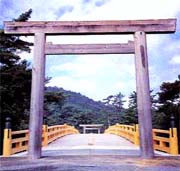| |
|
 |
What does Shintoism teach us about ecology?
 |
 |
 |
A torii, the traditional gate marking the threshold of the sacred grove surrounding a Shinto shrine |
Nature as Divine
Shinto tradition acknowledges a deep debt to the blessing of nature and the spiritual power which brings about life, fertility, and prosperity. This life-giving power was called Musubi (divine power of growth), and perceived in all the workings of nature. Since the Japanese people felt the divine within nature, they came to hold the ideal of a life that was in harmony with and united with nature. Mountains peaks, deep valleys, and the wide ocean were viewed as dwellings for the divine, and other natural objects such as evergreen trees and huge rocks were considered to be symbols of divine spirits.
Shinto and Agriculture
The Japanese way of life depends heavily on rice cultivation, the form of agriculture best suited to the Japanese climate. Rice is treated as a sacred and indispensable food. Matsuri festivals are traditionally held seasonally in each region to invoke the success of the rice harvest. Over thousands of years, the rituals and festivals associated with rice agriculture gave form to the religion of Shinto. Shinto is therefore both the indigenous folk religion of Japan, and the history of the Japanese people's way of life.
Shrines as forest sanctuaries
Along city avenues and in the valleys formed by busy urban streets, wherever the Japanese people make their lives, one will always find a luxuriant green of trees. The grove is a ritual space for the worship of the deities, and as such is a part of nature which has been preserved by the Japanese people since ancient times. And it is within such groves that one finds the kami deities are enshrined.
|
 |
|
|
|
|
|
 |
Shinto Forestry
It is the forests, and not the buildings, that mark the true shrines of Shintoism. The deities are invited to these forests, where they and their environment are protected by the local community, which in turn is protected by the deities. |
 |
Religious Forests
Sacred woods, forests and trees are found in all the major religious cultures of the world. The tree forms a fundamental part of the mythology of many faiths, from the Tree of Knowledge in Judaism and Christianity’s Tree of the Cross to the sacred trees of Hinduism.< |
 |
John Smith of ARC, at Lambeth, 2005:
|
 |
 |
|
|

